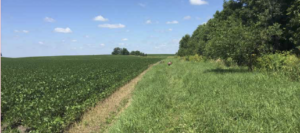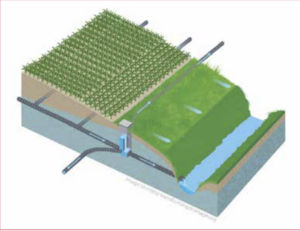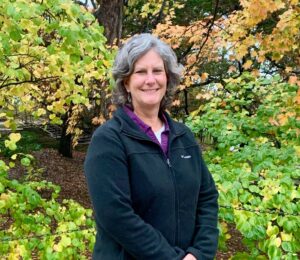Getting into Soil and Water 2020

The Perks of Buffers
Replacing farmland adjacent to streams with grasses or forests provides many benefits to agricultural ecosystems. Commonly referred to as riparian buffers, perennial vegetation planted along stream corridors improves wildlife habitat and reduces soil erosion and nutrient losses from overland water flow (Lee et al., 2000). Properly managed buffers have been shown to increase the quantity and diversity of bird species and pollinators, considered vital to agriculture sustainability (Bradbury et al., 2019). Buffered streambanks are also less susceptible to soil erosion, losing up to 80% less soil than row cropped or grazed stream banks (Schultz, 2004). Riparian buffers have also been shown to remove nitrogen from groundwater leaving agricultural fields. Microbes in the soil use the nitrogen as an energy source, converting nitrate to non-reactive nitrogen gas. The United States Department of Agriculture has acknowledged the multifunctional benefits of riparian buffers by promoting them as a part of the Conservation Reserve Program (CRP). Over 1.2 million acres of farmland are currently enrolled in filter strip or riparian buffer CRP contracts, and Iowa leads the country with over 200,000 acres enrolled (FSA, 2019). Traditional riparian buffers play a key role in improving water quality in Iowa by reducing soil and nutrient losses from water moving across the land surface, but they are ineffective at removing the bulk of nitrogen lost from Iowa farmland that is routed to streams in subsurface tile drains.
Tile drains are commonly installed on poorly drained soil, lowering the water table to improve crop yields. Drainage water often contains elevated concentrations of soluble nutrients, including nitrate. The 17.4 million acres of drained land in the Midwest act as the largest source of nitrogen to the Gulf of Mexico, contributing to an annual Hypoxic Zone. Hypoxia is caused in the Gulf of Mexico from excess nitrogen and phosphorus contributing to algal blooms and the subsequent depletion of oxygen from algal decomposition. Each state in the Mississippi River Basin has implemented a nutrient reduction strategy to reduce the size of the Hypoxic zone in the Gulf of Mexico. Iowa is one of the largest nutrient contributors to the Gulf and was the first state to implement a nutrient reduction strategy. Iowa’s strategy uses both in-field and edge-of- field conservation practices to reduce nutrient losses from Iowa. One of these edge-of-field practices redesigns traditional riparian buffers to also remove nitrogen from tile drainage. Referred to as saturated riparian buffers (SRBs), nitrate is removed from tile water by rerouting the water back into the buffer before it reaches the stream.

How Saturated Riparian Buffers Work
Saturated riparian buffers work by intercepting a tile drain as it leaves the field and crosses into a riparian buffer. Tile water is diverted into a distribution pipe where it then seeps through the buffer’s soil to the stream. To construct a SRB, a two chambered water control structure is placed at the field outlet. See Figure 1. The chambers are separated by flashboards set to a depth that raises the water table in the buffer without pushing water back into the field. Tile water leaves the field and enters the first chamber where it flows into one of two distribution outlets located on each side of the control structure. Distribution pipes are installed to a depth of around 2 feet and run parallel to the stream. The flashboards dividing the two chambers raises the water level in the control structure forcing water into the distribution pipes, where it then moves as shallow groundwater through the buffer. In cases of high flow from tile drains, the second chamber houses an overflow discharge pipe to prevent water backing up into the adjacent field. Once nitrate rich tile water becomes shallow groundwater in the riparian buffer, nitrate can be removed by microbes or plant uptake. Riparian buffers remove around 50% of the nitrate that leaves the field, or 134 lbs N per drained acre (Jaynes and Isenhart, 2018). Recent research has determined the majority of nitrate removed from SRBs is likely by microbes converting nitrate to non-reactive nitrogen gas in a process called denitrification (Groh et al., 2019). Saturated riparian buffers have shown early promise as a practice to remove nitrate from tile drainage and have been quickly integrated into the CRP program and the Iowa Nutrient Reduction Strategy. It will take a widespread implementation of SRBs alongside other conservation practices, including wetlands, cover crops, and woodchip bioreactors, to reach nutrient reduction strategy goals.
Morgan Davis, PhD
Postdoctoral Fellow Agronomy
Iowa State University
References:
Bradbury, S., Isenhart, T. M, and Schweitzer, D. 2019. Establishing and Managing Pollinator Habitat on Saturated Riparian Buffers. Iowa State Extension and Outreach. https://store.extension.iastate.edu/product/Establishing-and-Managing-Pollinator-Habi- tat-on-Saturated-Riparian-Buffers.
FSA. 2019. Conservation Reserve Program monthly summary: November 2019. Farm Service Agency, USDA, Washington, DC. https://www.fsa.usda.gov/ Assets/US- DA-FSA-Public/usdafiles/Conservation/PDF/November2019Summary.pdf (accessed 4 Jan. 2020).
Groh, T. A., Davis, M. P., Isenhart, T. M., Jaynes, D. B., and Parkin, T. B. 2019 In situ denitrification in saturated riparian buffers. J. Environ. Qual. 48:376-84. doi:10.2134/ jeq2018.03.0125.
Jaynes, D. B. and Isenhart, T. M. 2018. Performance of saturated riparian buffers in Iowa, USA. J. Environ. Qual. 48:289–296. doi:10.2134/jeq2018.03.0115.
Lee, K. H., Isenhart, T. M., Schultz, R. C., and Mickelson, S. K. 2000. Multispecies riparian buffers trap sediment and nutrients during rainfall simulations. J. Environ. Qual. 29:1200–1205. doi:10.2134/ jeq2000.00472425002900040025x
 Laura Frescoln joined the Iowa Water Center in October as a grant specialist. Laura has 4 years of grant experience in the non-profit sector and is excited to apply her knowledge and skills at the Iowa Water Center.
Laura Frescoln joined the Iowa Water Center in October as a grant specialist. Laura has 4 years of grant experience in the non-profit sector and is excited to apply her knowledge and skills at the Iowa Water Center.